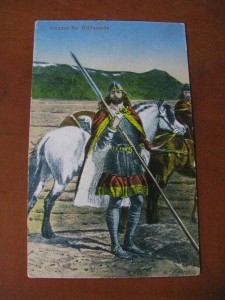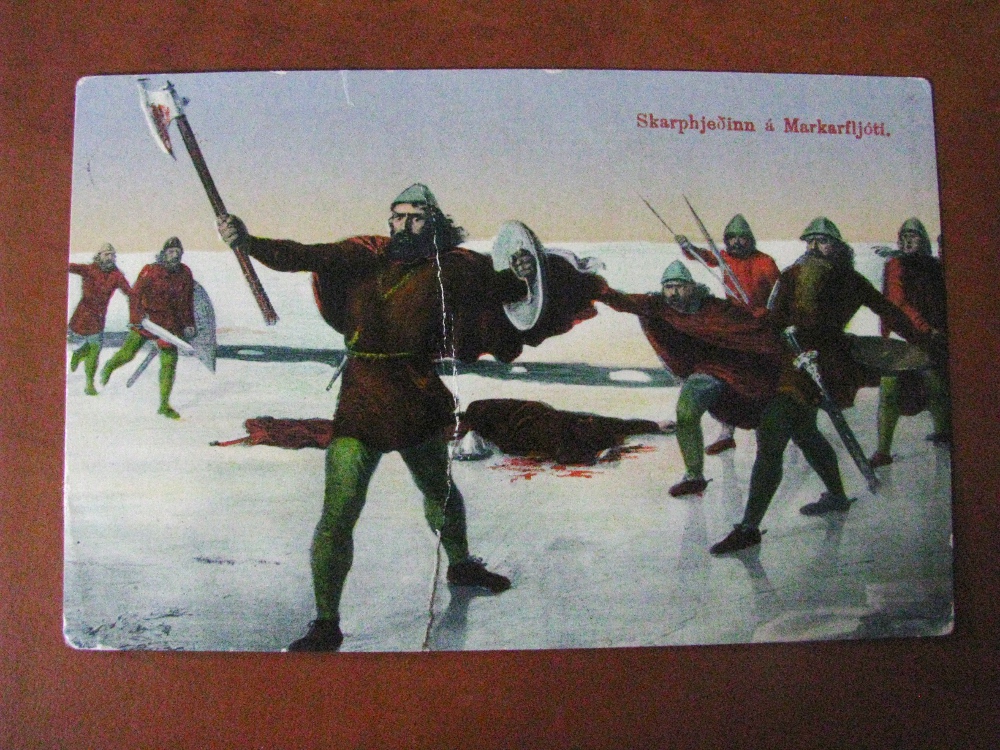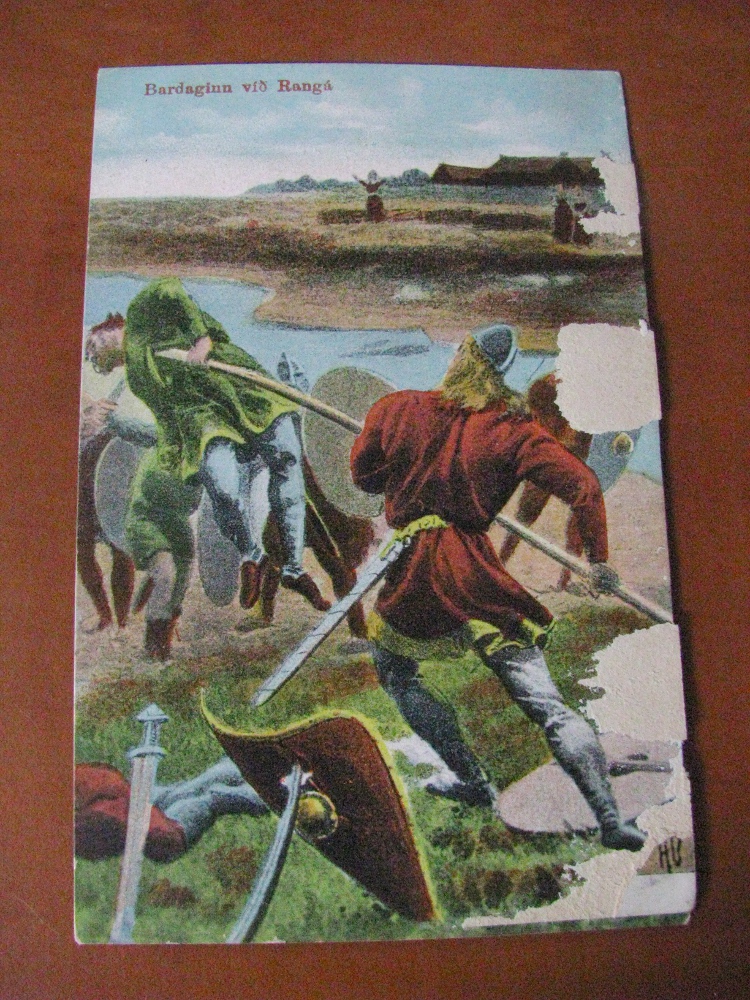Where the wild vikings are. Posted by hulda on Mar 17, 2014 in Icelandic culture, Icelandic history
 Icelandic sagas are an unusual feature in Medieval literature for several reasons. The most obvious one is that they mostly take part in Iceland and tell of ordinary people who, although heads of the society of their time, still are little more than rich farmers. There’s an amusing way people describe sagas here in Iceland – bændur að berjast (= farmers fighting) – which literally is what happens in all of them, although the farmers in question do part-time as warriors and when they get angry limbs go missing left and right.
Icelandic sagas are an unusual feature in Medieval literature for several reasons. The most obvious one is that they mostly take part in Iceland and tell of ordinary people who, although heads of the society of their time, still are little more than rich farmers. There’s an amusing way people describe sagas here in Iceland – bændur að berjast (= farmers fighting) – which literally is what happens in all of them, although the farmers in question do part-time as warriors and when they get angry limbs go missing left and right.
Another reason that makes them unusual is the sheer volume of them that still exist to this day. Icelandic manuscripts can thank one man for their survival – Árni Magnússon – whose groundbreaking attitude in saga collecting of the 1700’s meant that every piece, no matter how small, was kept and stored. The collection is now split in half with one part in Denmark and another in Iceland, divided roughly by the place where the sagas take place so that Iceland hosts the collection of most Icelandic sagas.
The third thing that sets the Icelandic manuscripts apart from the rest is the language. In Europe most manuscripts were written in Latin, but not so in Iceland where the language used was what we now call Old Norse. Such manuscripts exist elsewhere in North Europe as well but nowhere near in the same quantity (we’re talking dozens against thousands here).
Skarphéðinn and his axe, Ogress of War, doing a little slide-and-chop over the icy Markarfljót.
In short, Icelandic sagas are historical texts that describe the lives of people in Iceland in the Medieval era. They can be used as history books for the island to an extent, although some of the more fantastical parts of them like playing whack-a-mole with a ghost seal rising through the floor, or a warrior spearing enemies one by one, lifting them up on his spear and chucking them into a nearby lake singing all the while should probably be taken with a pinch of salt. Still, thanks to them we know f.ex. how Christianity arrived to Iceland, criticism on king Haraldur Fairhair, many counts of Old Nordic poetry that was already becoming an extinct form of art during the sagas’ time, only being known and practiced in Iceland… we also know many things about marriages, moral code, diet, mythology, clothing and how it was made, weapons, armour, power struggles (some of which can be backed with archaeological proof) and in general life in Iceland in the early years.
With such a lot of information readily available and translated onto countless other languages, wouldn’t you expect people to know quite a lot about the ancient Norse? Yet the main idea seems to be vikings, bloody raids, rape and murder. For many cultures the misrepresentations stem from lack of knowledge, but how’s that even possible when you have all those texts sitting under your nose that tell you otherwise? They’d tell you that vikings were not an ethnicity, the word means a specific type of a sailor and was attributed to only a small handful of people. They did go on raids but the generic idea of what those raids were like seems largely blown out of proportion. Let’s not even get to the horned helmets!
Famous heroes entering a scene: Snorri was a lawyer and so fierce at it that he managed to get rid of an entire horde of zombies by suing them until they ran away.
Perhaps it’s because the reality is far more complicated than that. As the sagas can tell most people were land owners and the fights between them were far more significant to them than viking raids. Even heroes such as Egill Skalla-Grímsson get far more pages written of their homeland activities than their heroics at war, or their viking raids, because that’s what really mattered to the people of their time: not what they supposedly did somewhere over the ocean but how they handled disagreements back home.
The causes of these disputes are many and varied. Feuds lasting for several generations could be started by an argument over which woman sat on the most important chair at a feast*, defecating on a holy ground**, being a perfect servant to a weak-minded king***, an argument over who cuts a shirt for which man****, not showing up to one’s own wedding and then, when the scorned bride is wed to another man, beginning a relentless fight over the lady (who herself at this point had sworn off her first suitor and kept her head to the end)***** and so forth. Of course the real reason behind were the families pitting their strength against each other, each side vying for the place of the most important family of the area, a feat that could only be brought about by skillful battles and equally well-arranged marriages.
Gunnar of Hlíðarend spearing his enemies one by one, lifting them up on the spear, throwing them into the river next to him… and composing little songs while at it. Then again Gunnar was such a fierce performer he zombied up after his death just to sing some more (when inspiration hits it’s time to sing, death is but a small hindrance).
In fact two themes do stand out over all of the others when it comes to Icelandic sagas, or family sagas as they’re also known as: family feuds and love. The most well loved of all the sagas are often the more romantic kinds such as Gunnlaugs saga Ormstunga, Laxdæla or Kormáks saga. Even the best known ones, Egill’s saga, Njála and Gísla saga put a lot of emphasis on the softer feelings of these “viking warriors” – Egill sends his own brother to certain death because he’s in love with his wife, Njáll’s saga describes several acts that are spurred on by love, such as the unfortunate marriage of Gunnar and Hallgerður that ends in disaster or Bergþóra who chooses to be willingly burned alive so she can share her husband’s fate. Gísla saga Súrssonar features a somewhat more radical type of wife, Auður, who physically fights off people trying to attack her husband. Viking raids? Those pale in comparison to what the sagas actually speak of!
In Iceland the sagas are still a staple, a part of the daily life that people know even if they haven’t actually read them. Everyone knows the heroics of Egill, Grettir, Gunnlaugur Snake-tongue, Gunnar, Snorri Góði and many more. Many can even recite the poetry these men created in their time and the most important works live on in songs. For example the love poem from Víglundar saga, Stóðum tvö í tuni (= We two stood on a meadow), performed here by the Medieval era re-enactors during the museum night.
Stóðum tvö í túni, tók Hlín um mig sínum
höndum, haukligt kvendi, hárfögr og grét sáran.
We stood two on a meadow, the goddess Hlín took me
Into her arms, the beautiful lady, fair-haired and cried bitterly.
(Hlín is a name of Frigg, the goddess of wifely love. This name, according to Eddic poetry, hints at her quality of defending people who are in danger and is often used as a kenning for a praise-worthy wife or betrothed.)
Titt flugu tár af tróðu, til segir harmr um vilja,
Strauk drifhvítum dúki drós um hvarminn ljósa.
Tears running from her eyes, told me of her will and pain,
wiped a snow-white cloth on her pale coloured cheeks.
*Brennu-Njáls saga: when two women cannot settle a seating order things escalate pretty quickly!
** Eyrbyggja saga: one family wants to poop on holy grounds while another family would rather that they didn’t.
*** Egils saga Skalla-Grímssonar: Egill’s uncle Þórólfur serves his king really well, but mistreats a lady that’s actually his family member via a forced marriage, so her sons turn the king against him. The king, Haraldur Fairhair, seems to have been easily swayed by his own paranoia and believes every conspiracy theory against himself, no matter how strange or far-fetched.
**** Gísla saga Súrssonar: or how you should check that the husband is not eavesdropping before you accuse his wife of sleeping with your brother. Failing that you may lose brothers.
***** Kormáks saga: the main character forgets his own wedding and dedicates his life to stalking the bride.
Today we’re heading out of Iceland and onto another, smaller island that speaks a tongue closely related to Icelandic – the Faroe Islands. I hope you excuse the leap outside of Iceland’s borders for the sake of Týr and some pretty awesome folk metal!
Regin Smiður (here). Lyrics, complete with an English translation, can be found here.
Ormurin Langi (here). I found lyrics here, but so far I have not found a translated version.
Ólafur Riddararós (here), lyrics + English translation here. The legend of Ólafur exists in Iceland as well, where he’s called Liljurós, Lily-rose, and the two stories differ but little. The Faroese Ólafur angers an elf lady by dumping her to get married to a human lady, whereas the Icelandic Ólafur simply turns down the elf lady’s advances. What both of the legends do have in common though is that the elf lady kills him, luring him in first by asking to kiss him.
All photos of this entry belong to me.

Build vocabulary, practice pronunciation, and more with Transparent Language Online. Available anytime, anywhere, on any device.
About the Author: hulda
Hi, I'm Hulda, originally Finnish but now living in the suburbs of Reykjavík. I'm here to help you in any way I can if you're considering learning Icelandic. Nice to meet you!








Comments:
Gina Conkle:
Great post, Hulda! Vikings and Iceland in particular fascinate me. I write Viking romance (and Georgian era romance) and love to dig deeper into the history and the Sagas.
I look forward to more of your blogs-
Gina
hulda:
@Gina Conkle Hi and thank you, I’m happy you liked it! History is my weak spot and history-based stories especially, it’s always wonderful to find an author who’s willing to pick such a demanding set as times gone past as their topic!
Now that I have the perfect excuse for it, expect more Medieval era -related posts! 😀